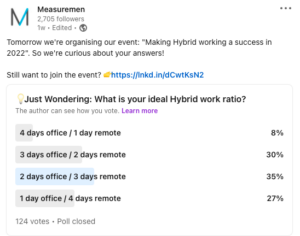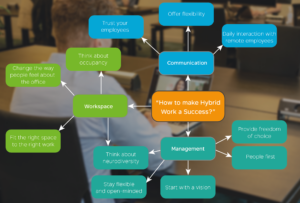Since offices (partially) opened their doors again, we embraced hybrid working. However, we are still trying to find out how we can make hybrid work a success. We and our clients still have a lot of challenges and questions to be answered. We need to think about how we can support employees working from home, at the office, or elsewhere. It is still a question of how hybrid work affects productivity. Besides while working hybrid, we need to foster employee health and well-being, how do we do that? To answer these questions, we organised a panel discussion with several workplace experts:
- Darren Atkinson: Founding Director at Protostar
- Miles Mcleod: Senior Workplace Consultant at Morgan Lovell
- Natalie Smith: Associate Principal Planning & Strategies at Perkins+Will
- Steffie Desart: Prevention Advisor Psychosocial Aspects at Idewe (in absence)
One thing is for sure, hybrid working is here to stay. Our poll confirmed this, showing that 35% preferred a ratio of 2 days at the office and 3 days remote. But there is much more to it than that. The panel discussion, hosted by Measuremen’s Noel Brewster and Natacha Willhalm, will dive deeper into this.
The definition of hybrid working
The discussion starts off with the most important but also difficult question “What is the definition of Hybrid working?” Host Noel Brewster proposes “A flexible work model that supports a blend of in-office, home, and on-the-go workers. It should empower employees to choose where and how they are most productive”. But Natalie aptly commented that hybrid working is much more than just talking about the place of work. It’s also fundamentally how people communicate, changing the organisational structures. Darren adds that it’s still evolving. According to him, nobody is really working hybrid yet. We’re just talking about a binary separation of home and office. Real hybrid working starts when the physical workplace and the digital workplaces merge together. Synchronicity is the important objective here, and this definition is still evolving, he says.
Mental health and well-being in the workplace
This topic starts with a poll for the attendees and shows that according to them, mental health has been improved while hybrid working. The discussion that follows highlights the importance of flexibility and freedom of choice. Both Darren and Miles agree that flexibility plays a very important role in the well-being of employees. Being able to bring your kids to work, or finishing your work early to go to the gym, has a positive impact on well-being. Miles adds that when working from home is enforced, a lot of people struggle with isolation. But giving freedom to and trusting your employees really makes a difference. Steffie commented (on paper) that the risk is here to assume what the other party wants. Managers and employees should communicate effectively and openly to understand the basic needs of each other.
When it comes to future workplaces, Darren adds that no one is really talking about neurodiversity yet. There is a strong focus on the office as being a social place, becoming designed for extraverted people. But there are also people who need and require different workspaces. This requires more attention to inclusivity and the well-being of all employees. It’s all about choosing the right space for the right work!
How to support employees while working at home, in the office, or elsewhere?
When asking what people feel is the most important thing to support employees with Hybrid working through the poll, the most common answer was communication and human interaction.
Natalie says that it’s important to “have an understanding as a team, as a wider business, what are the types of meetings or goal-oriented meetings that we want to have in person. Giving people an understanding of what is ok to be done hybrid or actually even better, and what needs to be done in person?” Through this framework of expectations, people can schedule their weeks by accounting for what’s right for the business and sustain their own flexibility.
Another issue is identified by Miles as the quality of hybrid meetings: “It’s very important to not treat virtual attendees as second-class citizens”. It’s all about changing people’s ethics both on the VC (virtual collaboration) platform but also in the meeting room itself. VC platforms play a big role in this, but also the design of meeting rooms. “Now all meeting rooms need to be conference rooms or hybrid meeting rooms. They all need to be enabled because ultimately they are not going to function as a conference room if they are not equipped with the right technology and the right furniture.”
The impact of hybrid working on productivity
According to a recent survey by Deloitte, 55% of employees feel as productive or more productive since the pandemic. Natacha, being hired remotely at Measuremen, notes how she shares that feeling of being productive and engaged with her organisation while she has never visited the office. However, she also notes that her daily interactions are very important to be strongly connected to her colleagues and her company. Nevertheless, hybrid working has an effect on productivity and on the office. What do you think about that?
Miles thinks it’s a misconception that employees always want to work from home, and managers always want to have employees working at the office. In general, managers are more likely to put the business first, but there are many organisations that thrived during the lockdown, showing that it’s possible to work remotely effectively.
Creating a framework or looking at the experience?
Organisations could make a framework with conditions that keep the organisation running smoothly. An outcome of this framework could be that people need to be (at least) one day at the office. For the rest of the week, employees can sustain their flexibility and find their way to do their work where.
Natacha adds that another question they received was about employee experience, related to this topic. What could organisations do to boost this?
Natalie answers by saying: “We see that organisations are working on turning the office into a space for curating experiences, to connect people, for creative work, networking, and drinks and events. Create the experience that people want to experience. Change the way people feel about the office”. However, Darren comments on this by saying that events-driven attendance doesn’t seem to work with many remote workers anymore. They work for the people at the office, not for remote workers. Instead of just looking at the physical space, I’ve been taking a step back and looking at the cultural space. What is it that we need to work together? There might be no answers to that yet, but there are multiple possibilities. The time runs out now, so Noel Brewster asks for one closing thought on how to make Hybrid working a success.
How to make hybrid working a success?
Miles: People first. Listen to your employees and use anonymised data to deal with expectations. It’s about that level of engagement and tactful communication.
Natalie: Stay flexible and open-minded, see what shape it’s going to take now and in the future. We are at the start of this journey, and it’s not set in stone how it will go.
Darren: It’s about synchronicity. We need to shift the conversation towards when we work. How it is coordinated, and not just only where we work.
Steffie: One factor is essential and that’s vision. First, start with a vision, know what you want. Then, start facilitating how you want to reach that vision. Organisations have to keep in mind that there is only one summon. And that summon is different for each organisation. So learn from other organisations, but ‘you do you’, do your own thing and live by it.





